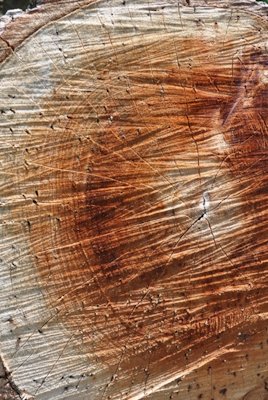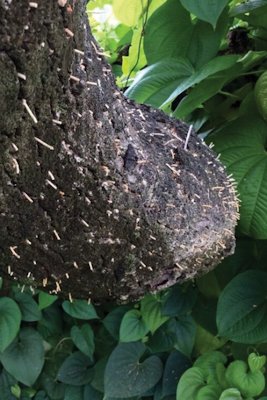Article Edible South Florida
by Jeff Wasielewski, Extension Connection
Avocado Alarm: Laurel Wilt

In early 2002, somewhere near the meandering Savannah River in
Georgia, a tiny female ambrosia beetle emerged from a wooden packing
crate, flew inland toward a small stand of native redbay trees and
began to drill. Fifteen years later, we have lost half a billion native
trees and over 25,000 avocado trees to the deadly disease laurel wilt.
This kills through a combination of an introduced pest, the redbay
ambrosia beetle; an introduced fungus, Raffaelea lauricola; and a severe overreaction to the presence of the fungus by host plants. These include the avocado (Persea americana), a beloved South Florida fixture, and the previously indestructible native plants swampbay (Persea palustris) and redbay (Persea borbonia),
all members of the laurel family. The $54 million Miami-Dade avocado
industry has already lost close to 25,000 commercial avocado trees to
laurel wilt or disease-related removals, while native trees have
suffered even greater losses.
Signs of Laurel Wilt
The
fungus itself is not deadly to the infected trees, nor is the vector.
Trees die by overreacting to the presence of the fungus. Once a female
ambrosia beetle drills into a suitable tree, she begins to grow the
fungus to feed herself and her young. The tree overreacts and tries to
wall off the fungus to protect itself. The tree does this so quickly
and efficiently that it effectively cuts off its own water and nutrient
supply, causing its leaves to rapidly wilt, turn brown and hang on the
tree before dying.
The redbay ambrosia beetle brought laurel
wilt to South Florida, but once it got here, other ambrosia beetles
that were already here also began to farm the same fungus. A few of
those beetles are the ones thought to be causing avocado damage. The
disease can be spread by ambrosia beetles, but also through root
grafting. In an avocado grove, the disease will often travel right down
a row tree by tree.
 |  | Photo 1: Trunks reveal beetle holes
Photo 2: Sawdust tubes on trunk |
How to Manage Laurel Wilt
If
you're a commercial avocado grove owner, check out this protocol
developed by UF/IFAS. The most important thing grove owners can do is
to consistently scout their groves and to quickly rogue any
laurel-wilt-affected tree before the disease can spread through the
roots to its neighbor. Lateral root transmission is much more efficient
and quick than beetle transfer.
If you’re a homeowner, keep your
tree healthy through proper horticulture and don’t bring in any wood to
your property that may be in the laurel family as that wood may harbor
beetles. Any large, dead tree on your property is a hazard, so have it
safely removed by a certified arborist.
Jeff Wasielewski, the commercial fruit crops extension agent for the University of Florida and Miami-Dade in Homestead...
|
|
Bibliography
Wasielewski, Jeff. "Avocado Alarm: Laurel Wilt." Edible South Florida, 30 Aug. 2017, ediblesouthflorida.ediblecommunities.com/things-do/avocado-alarm-laurel-wilt.
Accessed 30 Apr. 2020.
Photographs
Wasielewski, Samantha C. "Avocado Alarm: Laurel Wilt." Edible South Florida, 30 Aug. 2017, ediblesouthflorida.ediblecommunities.com/things-do/avocado-alarm-laurel-wilt.
Accessed 30 Apr. 2020.
Published 30 Apr. 2020 LR
|


